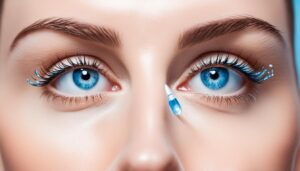Did you know that up to 2-5% of the population may have aphantasia, a condition characterized by the inability to visualize images in their mind’s eye?
If you’ve ever wondered if your visualization abilities are different from others, our simple aphantasia test can help provide answers. By engaging in a quick self-assessment, you can gain insights into the clarity and vividness of your mental imagery, offering a glimpse into the fascinating world of aphantasia.
Discover what people with aphantasia see or don’t see and explore whether the eyes can reveal if someone has aphantasia. With online test, you’ll have a better understanding of your visualization abilities and whether they align with the characteristics of aphantasia.

Key Takeaways:
- Up to 2-5% of the population may have aphantasia, a condition characterized by the inability to visualize images in the mind’s eye.
- Our simple aphantasia test is a quick self-assessment that can provide insights into your visualization abilities.
- The test helps you understand what people with aphantasia see or don’t see and explores the relationship between the eyes and aphantasia.
- By taking the test, you can gain a preliminary understanding of your mind’s eye capacity and whether it aligns with the characteristics of aphantasia.
- Exploring aphantasia can be a fascinating journey of self-discovery and awareness.
Understanding Aphantasia and the Mind’s Inability to Visualize
Aphantasia is a neurological condition characterized by the mind’s inability to visualize images. Unlike most individuals who can conjure mental images of people, places, and objects, those with aphantasia experience a blank or dark void when attempting to visualize. This phenomenon can be quite perplexing to those who have never encountered it, leading to a need for deeper understanding and awareness.
So, what exactly is aphantasia? Aphantasia is defined as the inability to create mental images or visualize scenes in the mind’s eye. It is a cognitive difference that affects the way individuals perceive and interact with their imagination. While the term “aphantasia” was only coined in 2015, people have experienced this condition for their entire lives.
The causes of aphantasia are still not fully understood. However, existing research suggests that it may be associated with differences in brain structure and connectivity. Some studies have found that individuals with aphantasia exhibit reduced communication between certain brain regions responsible for imagination and visualization.
Understanding aphantasia is essential to comprehending the experiences of those with this condition, as well as fostering awareness and acceptance in society. By delving into the concept of aphantasia and exploring its definition and underlying causes, we can begin to appreciate the unique perspectives and challenges faced by individuals with aphantasia.
Exploring the Vividness of Visual Imagery Questionnaire
What is the Vividness of Visual Imagery Questionnaire?
The Vividness of Visual Imagery Questionnaire is a psychological assessment tool designed to measure the clarity and intensity of an individual’s mental imagery. It consists of a series of questions and scenarios that require participants to visualize specific objects or scenes and rate the vividness of their mental images.
How the Questionnaire Measures Your Mental Imagery
The questionnaire presents participants with various scenarios and asks them to visualize and rate the vividness of their mental images on a scale ranging from no image at all to a clear and lively image as real seeing. The responses provide insights into the individual’s ability to generate vivid mental images.
Interpreting Your Score on the Imagery Vividness Scale
The scores obtained from the Vividness of Visual Imagery Questionnaire can help individuals understand the extent of their mental imagery abilities. Higher scores indicate a greater ability to visualize vivid mental images, while lower scores may suggest aphantasia or a limited ability to generate visual mental imagery.
The Relationship Between Aphantasia and Dreams
Can Individuals with Aphantasia Experience Visual Dreams?
One common question is whether individuals with aphantasia can experience visual dreams. Research suggests that while some individuals with aphantasia do report having visual dreams, others may not experience vivid visual imagery during their dreams.
The Phenomenon of Dreaming for Aphantasics
The phenomenon of dreaming without mental imagery is unique for individuals with aphantasia. While their dreams may lack the visual component, they can still experience other sensory aspects such as emotions, sounds, and narratives.
Understanding Dream Patterns in Aphantasia
Research into dream patterns of individuals with aphantasia is still ongoing. Studies aim to explore whether there are any distinct differences in dream themes, content, and emotional experiences between individuals with aphantasia and those without. By understanding dream patterns in aphantasics, researchers can further unravel the mysteries of the mind and contribute to the understanding of aphantasia as a whole.
Simple Aphantasia Test: Discover Your Mind’s Eye Capacity
Are you curious about your mind’s ability to visualize images? Take our simple aphantasia test to gain insights into your mind’s eye capacity. This test will guide you through a series of visualizations and help you evaluate the clarity and vividness of your mental imagery. By following the instructions and answering the questions honestly, you can better understand your visualization abilities and determine if you exhibit signs of aphantasia.
To start the test, find a quiet and comfortable space where you can concentrate without distractions. Let’s begin!
- Close your eyes and imagine a vivid red apple in front of you. Rate the clarity and vividness of the mental image on a scale of 1 to 10, with 1 being no image at all and 10 being a perfectly clear and vivid image.
- Now, visualize a peaceful beach with crashing waves. Rate the clarity and vividness of the mental image on the same scale.
- Imagine a loved one’s face smiling at you. Rate the clarity and vividness of the mental image on the scale.
- Picture yourself walking through a dense forest. Rate the clarity and vividness of the mental image.
- Next, visualize a soaring eagle flying across the sky. Rate the clarity and vividness of the mental image.
Once you have completed these visualizations, reflect on your ratings and consider the overall clarity and vividness of your mental images. Keep in mind that everyone’s visualization abilities vary, and there is no right or wrong result.
If you consistently rated the mental images with low numbers (1-4) and struggled to visualize the objects and scenes, you may have aphantasia or a limited ability to generate visual mental imagery. However, only a professional assessment can provide a definitive diagnosis.
Remember, this is just a preliminary test and should not replace a medical or psychological evaluation. If you have concerns about your visualization abilities, we recommend consulting a healthcare professional or psychologist for a thorough assessment.

How to Identify Signs of Aphantasia in Daily Life
To understand whether you may have aphantasia, it is essential to recognize the signs and indicators of this condition in your daily life. Aphantasia can manifest in various ways, affecting your ability to daydream, remember faces, navigate spaces, and engage in creative problem-solving.
Daydreaming and Imagination: Key Indicators of Aphantasia
A prominent sign of aphantasia is the absence or limited ability to daydream and engage in vivid imagination. Individuals with aphantasia might struggle to create mental images during daydreams or imagine scenes and scenarios in detail. Without the ability to visualize, their internal experiences may lack the richness and depth of visual imagery.
Challenges in Remembering Faces and Navigating Spaces
Aphantasia can also impact face recognition and spatial navigation. Since individuals with aphantasia cannot visualize facial features, they may face challenges in remembering and recognizing faces. This can affect their social interactions and ability to recall individuals they have met.
Moreover, the absence of mental imagery in aphantasics can impact their spatial navigation skills. Visualizing and creating cognitive maps of physical environments becomes challenging, leading to difficulties in navigating spaces and finding their way.
Aphantasia’s Impact on Creativity and Problem-Solving
Aphantasia can have implications for creativity and problem-solving processes. While individuals with aphantasia may face limitations in certain creative endeavors that heavily rely on mental imagery, such as visual arts or design, they may excel in other areas that do not require visualization. Their unique cognitive perspective may offer fresh insights and alternative approaches to problem-solving.
Exploring the relationship between aphantasia and creativity can shed light on the diverse ways in which individuals perceive and process information, fostering a deeper understanding and appreciation for cognitive diversity.

Seeking Professional Insights: When to Consult a Neurologist
If you have taken the self-assessment and online tests to gain insights about your aphantasia and still have questions or concerns, it may be appropriate to seek professional guidance. Consulting a neurologist can provide a more comprehensive understanding of your condition and help you navigate the next steps in your journey.
A medical evaluation by a neurologist can offer expert insights into aphantasia, its causes, and potential treatment options. Additionally, a neurologist can conduct a thorough examination of your neurological health to rule out any underlying conditions or determine if aphantasia is a standalone issue.

Seeking professional insights for aphantasia can be beneficial in several ways. It allows for a more accurate diagnosis, ensuring that you have a clear understanding of your condition. A neurologist can provide personalized recommendations and guidance based on your specific needs and circumstances.
Furthermore, consulting a neurologist can be a stepping stone towards accessing appropriate resources, support networks, and further medical evaluations. A neurologist can help connect you with specialists and therapists who specialize in cognitive disorders and offer strategies to cope with the challenges associated with aphantasia.
Remember, aphantasia is a unique condition, and seeking professional insights can provide you with the knowledge and tools necessary to navigate your experience and find support. If you have questions or concerns about aphantasia, consider consulting a neurologist to receive expert guidance and medical evaluation.
Conclusion
Debunking Myths and Embracing Cognitive Diversity
In conclusion, it is important to debunk common myths surrounding aphantasia and emphasize the significance of embracing cognitive diversity. Aphantasia is a unique cognitive trait that does not indicate diminished intelligence or imagination. Contrary to misconceptions, individuals with aphantasia possess a rich inner world that may be expressed through other senses and cognitive processes. By debunking these myths, we can foster greater understanding and acceptance of individuals with aphantasia, promoting inclusivity and diversity in our society.
Next Steps After Self-Diagnosis: A Roadmap for Aphantasics
After self-diagnosing aphantasia, individuals may wonder about the next steps to take. It is important to remember that aphantasia does not define a person’s abilities or limit their potential. There are various resources and support groups available that can provide valuable insights and strategies to cope with the challenges associated with aphantasia. Additionally, embracing the unique aspects of having aphantasia can lead to discovering alternative avenues for creativity and problem-solving. By seeking support, individuals with aphantasia can embark on a roadmap towards self-discovery and personal growth.
Recognition and Support for Aphantasia in the Professional Field
In the professional field, it is crucial to recognize and support individuals with aphantasia. Promoting awareness and understanding of aphantasia among professionals in various industries can create an inclusive environment that accommodates the diverse needs of individuals with this cognitive trait. By recognizing the unique perspectives and strengths of aphantasics, professionals can foster equal opportunities and ensure that all individuals, regardless of their visualization abilities, can thrive in their respective fields. Recognition and support for aphantasia contribute to a more inclusive, diverse, and innovative professional landscape.
FAQ
What is a simple aphantasia test?
A simple aphantasia test is a quick self-assessment that helps individuals understand their mind’s ability to visualize. It involves visualizing specific objects and scenes and rating the clarity and vividness of the mental images on a scale.
How do you test if you have aphantasia?
You can test if you have aphantasia by taking a simple aphantasia test. This test involves visualizing various objects and scenes in your mind and rating the clarity and vividness of your mental imagery.
What do people with aphantasia see?
People with aphantasia do not see mental images in their mind’s eye. Instead, they experience a blank or dark void when attempting to visualize.
Can the eyes reveal if someone has aphantasia?
No, aphantasia cannot be determined by looking at a person’s eyes. Aphantasia is a phenomenon that occurs within the mind and is not visually recognizable.
Is there a free online aphantasia test available?
Yes, there are free online aphantasia tests available that can provide you with a preliminary understanding of your visualization abilities. These tests typically involve visualizing objects and scenes and rating the clarity and vividness of your mental images.
How does the Mind Eye Aphantasia Test online work?
The Mind Eye Aphantasia Test online typically asks you to visualize specific objects and scenes and rate the clarity and vividness of your mental images. The test provides insights into your ability or inability to generate visual mental imagery.
What is the BBC Health Aphantasia Test?
The BBC Health Aphantasia Test is an online test that helps individuals determine the clarity and intensity of their mental imagery. It typically involves visualizing specific objects and scenes and rating the vividness of the mental images.




